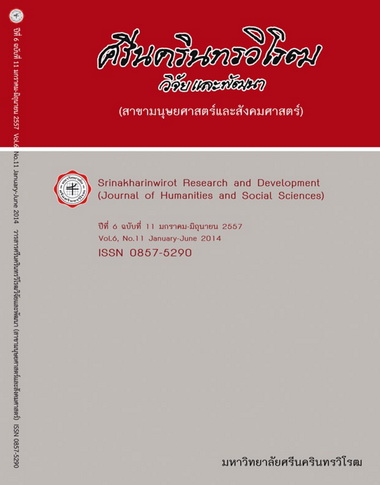การเปรียบเทียบภาษาและวัฒนธรรมไทยกับเกาหลี A COMPARATIVE STUDY ON LINGUISTIC CULTURE OF KOREAN AND THAI
Keywords:
Korean language, Thai language, linguistic culture, language and culture, Thai linguistic culture, Korean linguistic cultureAbstract
บทคัดย่อ
การวิจัยนี้นำเสนอการวิเคราะห์เปรียบเทียบระหว่างวัฒนธรรมการใช้ภาษาของเกาหลี
และไทย จากลักษณะวัฒนธรรมเกี่ยวกับอาหาร เสื้อผ้า และที่อยู่อาศัย อันสะท้อนให้เห็นถึงระดับภาษาและแสดงให้เห็นว่าภาษาสะท้อนวัฒนธรรม
วัฒนธรรมทางภาษาของภาษาเกาหลีและภาษาไทยที่เกี่ยวข้องกับอาหาร เสื้อผ้า และที่อยู่อาศัย มีการกล่าวไว้ว่า วัฒนธรรมเสื้อผ้าระหว่างเกาหลีกับไทยมีขนาดและมีรูปทรงที่แตกต่างกัน เนื่องจากความแตกต่างทางสภาพภูมิอากาศอากาศ รวมถึงสถาบันพระมหากษัตริย์ และความเชื่อทางพระพุทธศาสนา
วัฒนธรรมเกี่ยวกับอาหาร นั้น ประเทศเกาหลีได้มีการพัฒนาวัฒนธรรมอาหาร จากพื้นฐาน
ชีวิต คือ ข้าว กิมจิ และปลาเค็ม นำไปสู่พัฒนาการที่หลากหลายของคำศัพท์ที่เกี่ยวข้อง ในขณะเดียวกัน วัฒนธรรมอาหารของไทยก็มีข้าวและปลาเป็นพื้นฐานชีวิตเช่นกัน ส่งผลสู่การพัฒนาและคำศัพท์ที่เกี่ยวกับอาหารการกิน รวมไปถึงสถาบันพระมหากษัตริย์ และพระสงฆ์ ซึ่งนับเป็นอีกปัจจัยหนึ่งในการพัฒนาในทางภาษาให้เกิดความหลากหลาย
วัฒนธรรมที่อยู่อาศัยในประเทศเกาหลีมีหลากหลายแบบ ทั้งวิธีการปลูกสร้าง และรูปทรงของอาคาร จึงเป็นที่มาของการพัฒนาคำศัพท์ที่เกี่ยวข้อง สำหรับประเทศไทยมีลักษณะที่อยู่อาศัยแตกต่างกันและมีชื่อเรียกต่างกันขึ้นอยู่กับสถานภาพและฐานะทางสังคม
การวิจัยครั้งนี้ย่อมก่อให้เกิดประโยชน์ทั้งสำหรับชาวไทยที่เรียนภาษาเกาหลี และชาวเกาหลีที่เรียนภาษาไทย จะได้เกิดความรู้ความเข้าใจเชิงลึกในวัฒนธรรมทางภาษาเกาหลีและภาษาไทย
Abstract
This study presents a comparative analysis of how Korean and Thai living culture based on food, clothing and housing was reflected in their respective languages with the presupposition
that language reflects culture.
When linguistic culture of Korean and Thai languages relating to food, clothing and housing is reviewed, for clothing culture, there is a difference in shapes between Korean and Thai clothing due to weather difference in royal family and Buddhist between the two countries.
For food culture, Korea has developed a food culture centering on rice, kimchi and salted fish, leading to a diverse development of corresponding vocabularies. Meanwhile, in Thailand, food culture centering on rice and fish has developed, and vocabularies on food eaten by royal families and monks have been developed in a diverse way.
For housing culture, in Korea, there are diverse kinds of residences according to building methods and shapes, leading to a corresponding vocabulary development. In Thailand, residences differ in their names depending on their occupants’ social position and status.
This research is believed to be of great help to Thais who learn Korean language, and to Koreans who learn Thai in having an in-depth understanding of Korean linguistic
culture and Thai linguistic culture.
Downloads
Downloads
Published
How to Cite
Issue
Section
License
Srinakharinwirot Research and Development Journal of Humanities and Social Sciences is licensed Under a Creative Commons Attribution-NonCommercial-NoDerivs 4.0 International (CC-BY-NC-ND 4.0) License, Unless Otherwise Stated. Please Read Journal Policies Page for More Information on Open Access, Copyright and Permissions.



